There are 14 turtles in West Virginia. Some of the species are endangered or threatened due to habitat loss, poaching, and invasive species.
Ten species are native to West Virginia, nine of which are aquatic. The Eastern Box turtle is the only species that favors dry land.
All these turtles favor a specific food, habitat, and nesting season. Some make great pets for turtle lovers, while others are best left in the wild. The carapace of each species tells a lot about their type.
In this article will find out the essential information about the turtles that dwell in the Mountain State.
Turtles in West Virginia
1. Common Snapping Turtle
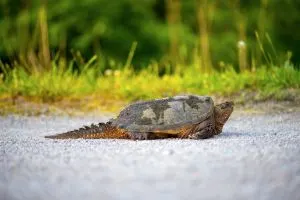
- Experience Level: Intermediate
- Family: Chelydridae
- Scientific Name: Chelydra serpentina
- Other Names: Snapping turtle
- Adult Size: 8 to 20 inches
- Lifespan: 30 to 50 years
- Average price range: Between $20 and $40
- Recommended Books: Snapping Turtle Care Guide by Ben Team
The Common Snapping turtle, or the Snapping turtle, is a freshwater turtle that favors rivers, lakes, and marshes. It’s a relatively large North American species that prefers hiding underwater in sediment.
One feature that makes the turtle unique is its saw-like tail, which can be as long as the shell. The upper shell, or the carapace, has three ridges. The neck can stretch the length of the shell.
If it feels threatened, the Common Snapping turtle might get aggressive. It is one of the more aggressive turtles after all. That’s why it’s a bad idea to pick it up by the tail. The shell can be brown or blackish brown. The head’s color is the same as the shell; however, the neck and limbs are yellowish.
This turtle type can live up to 100 years, yet the average lifespan is 30 years in the wild. The most vulnerable are the juveniles which risk being harmed by the predators.
They are omnivores, so eating fish, reptiles, frogs, and small mammals are just some of the foods they like.
2. Spotted Turtle
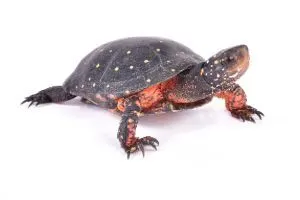
- Experience Level: Intermediate to Expert
- Family: Emydidae
- Scientific Name: Clemmys guttata
- Adult Size: 4 to 5 inches
- Lifespan: Males up to 65 years; females up to 110 years
- Average Price Range: $200 to $300
- Recommended Books: The Spotted Turtle: North America’s Best
The Spotted turtle is a semi-aquatic turtle that inhabits wet meadows, marshes, lakes, and swamps. Hibernation occurs in winter when turtles hide inside the mud at the bottom of the river or lake.
Turtle lovers especially like to keep this species as pets because their size isn’t large, and they don’t require an extensive experience level.
Like many other turtles, the Spotted turtles are omnivores that feed on aquatic vegetation and invertebrates.
There are many differences between males and females Spotted turtles. The plastron of males is concave, while females have a convex one. The tail and eyes are different between males and females.
3. Wood Turtle

- Experience Level: Beginner
- Family: Emydidae
- Scientific Name: Glyptemys insculpta
- Adult Size: 7 to 8.25 inches
- Lifespan:40 to 58 years
- Average Price Range: $89.00 – $189.00
- Recommended Books: BASICS – Ecology, Husbandry & Breeding Spotted & Wood Turtles (Clemmys guttata & Glyptemys insculpta) – Guide Book
This turtle is endemic to North America. Many turtle enthusiasts can find it in West Virginia.
Many people may recognize the Wood turtle by observing the pyramidal shape of the scutes on the carapace. The upper shell’s length can reach 8 inches, and the color can be dark brown or black. The carapace is keeled and has a ridge going from front to back.
The bottom part of the shell or the plastron is yellow and has dark spots in the scute’s outer corners.
Keep in mind that the Wood turtle can look similar to the Bog turtle, Spotted turtle, and Blanding’s turtle, some of which live in West Virginia.
The species spends most of its time in the water with shallow and clear streams. It can also be found in forested areas. Like other turtle species found in West Virginia, the Wood turtle is an omnivore and can eat on land and in water favoring aquatic vegetation, invertebrates, various plants, and vegetables.
After the mating and nesting seasons are over, the female turtle covers the nest with leaves to protect the eggs from predators. Afterward, it leaves the nest until the next mating season approaches.
4. Eastern Box Turtle
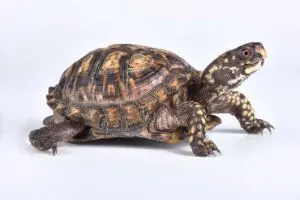
- Experience Level: Beginner
- Family: Emydidae
- Scientific Name: Terrapene carolina carolina
- Other Names: Land Turtle
- Adult Size: 4 to 7 inches
- Lifespan: 40 years
- Average Price Range: $260 – $360
- Recommended Books: Box Turtles (Complete Herp Care) by Tess Cook
The color of the Eastern Box turtle’s carapace is brown, covered with orange and yellow spots. It is high-domed and rounded. The plastron can be dark brown and hinged.
Another interesting fact about this species is that it has a hooked upper jaw, strong and webbed feet. The tails of the males are shorter and thicker compared to the females’.
Unlike the Wood turtle, which is a semi-aquatic turtle, the Eastern Box turtle is terrestrial. You can find it in vegetative areas, open woodlands, field forest edges, and marshy meadows.
This turtle type is an omnivore favoring plants, fruits, eggs, insects, and animal carrion. Juveniles are carnivorous as they need protein when growing up.
5. Northern Map Turtle
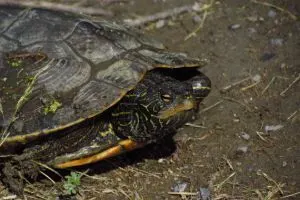
- Experience Level: Beginner
- Family: Emydidae
- Scientific Name: Graptemys geographica
- Other Name: Common map turtle
- Adult Size: Between 4 and 10 ½ inches
- Lifespan: 15 to 20 years
- Average price range: Between $20 and $60
- Where to buy: turtlestore.com
- Recommended Books: Map Turtles and Diamondback Terrapins (Herpetology Series) by W.P. Maura
The shell of the Northern Map turtle can be dark brown or olive green. This turtle type got the name from the markings which resemble the map contours. They are often yellow. You can distinguish the turtle from any other subspecies by the yellow spots behind the eyes.
They are aquatic species that spend most of their time in the water. They favor ponds, lakes, and rivers. Since the Northern Map turtles also like to bask, they inhabit areas with fallen trees and other debris.
These turtles are carnivores, which means they prey on fish and crayfish; however, they also eat plants.
6. Ouachita Map Turtle
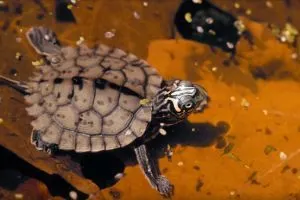
- Experience Level: Beginner
- Family: Emydidae
- Scientific Name: Graptemys ouachitensis
- Adult Size: 3 ½ to 5 inches for males, 5 to 10 inches for females
- Lifespan: Between 15 and 20 years
- Average Price Range: Between $40 and $100
- Where to buy: theturtlesource.com
- Recommended Books: Map Turtles and Diamondback Terrapins (Herpetology Series) by W.P. Maura
The Ouachita Map turtle is endemic to the United States and can be spotted in many countries, including West Virginia.
If you are a turtle enthusiast, you’ve probably noticed the large yellow spots on the sides of the Ouachita Map turtles’ heads, which make them distinguishable from other turtles.
Males are different from females. They have a prominent keel and dark green shells. Both male and female turtles like to be active throughout the day when they bask.
Like many other turtle species, the Ouachita Map turtles are omnivores, so they feed on mollusks, plants, and aquatic larvae.
7. Eastern Painted Turtle
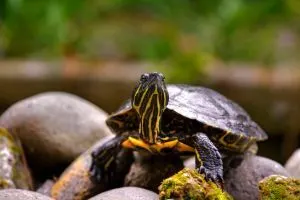
- Experience Level: Beginner
- Family: Emydidae
- Scientific Name: Chrysemys picta picta
- Adult Size: Between 5 and 7 inches
- Lifespan: Between 30 and 50 years
- Average price range: Between $20 and $50
- Recommended books: Painted Turtle Pet Owners Guide by Ben Team
The Painted turtle is the most widespread in North America. There are four subspecies of the Painted turtle, one of which is the Eastern Painted turtle.
It is a widespread species to keep as a pet, mainly because you don’t need to be an experienced turtle enthusiast and keeper.
This turtle type has a dark shell that is covered with yellow stripes. The plastron can vary from red to orange and has black and yellow patterns. There is a shadow-like patch situated in the center of the plastron.
The Eastern Painted turtle favors aquatic habitats since they are marine species. They like to stay near the water so they can bask.
These turtles are omnivorous, so their food includes mollusks, frogs, and underwater invertebrates.
8. Midland Painted Turtle
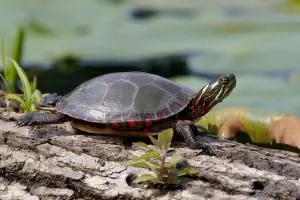
- Experience Level: Beginner
- Family: Emydidae
- Scientific Name: Chrysemys picta marginata
- Adult Size: Between 4 and 10 inches
- Lifespan: Between 30 and 50 years
- Average price range: Between $20 and $70
- Where to buy: Theturtlesource.com
- Recommended books: Painted Turtle Pet Owners Guide by Ben Team
The Midland Painted turtle is the hardest to distinguish from the other Painted turtle species. Experienced turtle lovers would recognize the characteristic symmetrical dark shadow on the plastron. The dark shadow might vary in size.
These turtles are freshwater turtles that like to inhabit soft-bottom bodies of water. They also enjoy plenty of vegetation and various basking sites.
The Midland Painted turtle’s carapace can be olive or black with red or dark orange markings. There are also red and yellow stripes on the turtle’s head and neck. The plastron is yellow or dark tan, and it also has a marking along the midline.
The nesting season begins in late May or early July. That’s when female turtles start digging their nests in loamy or sandy soil. The clutch size can be up to 14 eggs.
9. Red-eared Slider
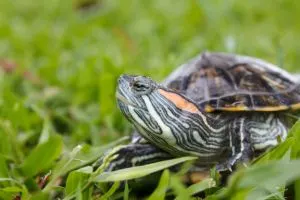
- Experience Level: Beginner
- Family: Emydidae
- Scientific Name: Trachemys scripta elegans
- Other Names: Red-eared Terrapins, Red-eared slider turtle, Slider turtle, and Water Slider turtle
- Size: 7 to 11 inches
- Lifespan: 30 to 40 years
- Average Price Range: $20
The Red-eared slider is a semi-aquatic turtle whose size varies from 7 to 11 inches. Female turtles are more extensive than males. Even though its lifespan is between 30 and 40 years, some turtles live longer than others.
The carapace’s color can be olive or brown, and it is covered with yellow stripes. Unlike the ones in captivity, the wild turtles have shells covered by a layer of algae.
The Red-eared slider’s name comes from the red stripes that can be seen behind the turtle’s ears and the ability to jump from rocks.
Their names come from the red stripes behind their ears and the ability to jump from the rocks and logs into the water. The Red-eared sliders are omnivores and feed on meat, fruits, aquatic plants, and vegetables.
10. Eastern River Cooter
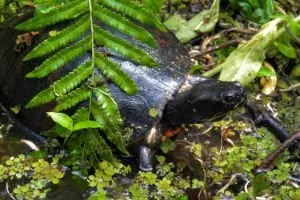
- Experience Level: Beginner to Intermediate
- Family: Emydidae
- Scientific Name: Pseudemys concinna concinna
- Adult Size: Between 8 and 12 inches
- Lifespan: Between 20 and 40 years
- Average Price Range: $20 to $50
- Recommended Books: Aquatic Turtles: Sliders, Cooters, Painted, and Map Turtles (Reptile Keeper’s Guide) by R.D. Bartlett (Author), Patricia Bartlett (Author)
These semi-aquatic turtles have domed shells that can be brown or olive. There are yellow markings on the shells and heads. The plastron is yellow.
The Eastern River cooters can breathe underwater and can be seen basking on rocks or at the edge of the water. Unlike other turtle types, the Eastern River cooter is herbivorous, which favors vegetation and fruits.
It inhabits many slow-moving waters, such as rivers and streams. Juvenile turtles resemble adult turtles in a general pattern. The carapace of a young turtle is green with yellow markings and has a keel.
The mating season begins in spring. Each season, the female turtle lays two or three clutches of eggs. The clutch size depends on the size of the female turtle. Usually, clutches’ size varies from nine to 30 eggs. The incubation period lasts around 85 days.
11. Northern Red-bellied Cooter
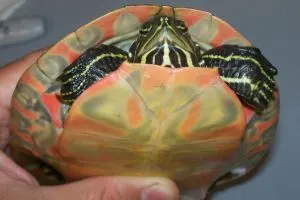
- Experience Level: Beginner to Intermediate
- Family: Emydidae
- Scientific Name: Pseudemys rubriventris
- Other Names: American red-bellied turtle
- Adult Size: Between 8 and 12 ½ inches
- Lifespan: Between 40 and 55 years
- Average Price Range: Between $30 and $170
- Recommended Books: Aquatic Turtles: Sliders, Cooters, Painted, and Map Turtles (Reptile Keeper’s Guide) by R.D. Bartlett (Author), Patricia Bartlett (Author)
The Northern Red-bellied cooter is the largest pond turtle in North America. You can see it in rivers and ponds with soft bottoms; however, basking is also essential.
The turtle’s name comes from its eponymous red-colored plastrons and the reddish lines on its scutes. The carapace’s color varies from olive green to black. There are yellow markings on the skin.
Unlike the Eastern River cooter, which is herbivorous, the Northern Red-bellied cooter is an omnivore when a juvenile. When it reaches a certain age, the turtle eats fruits, vegetables, and plants.
Female turtles lay 10 to 20 eggs in the nest near the water. Afterward, they cover it. After 10 to 16 weeks, the eggs hatch. The average lifespan of this turtle is between 40 to 55 years.
12. Common Musk Turtle
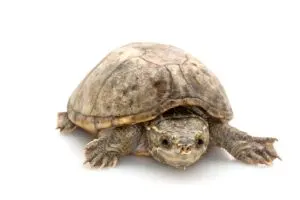
- Experience Level: Intermediate
- Family: Kinosternidae
- Scientific Name: Sternotherus Odoratus
- Other Names: Stinkpot, Eastern Musk Turtle
- Adult Size: Between 4 and 5 inches
- Lifespan: 50 years and over
- Average Price Range: Between $20 and $90
- Where to Buy: theturtlesource.com
The Common Musk turtle is a popular pet among turtle lovers due to its small size and ease of care.
The turtle’s name comes from the foul odor the turtle releases when it feels threatened. Even though they have a small size, this species’ lifespan can be longer than 50 years.
This turtle’s shell is dark and unmarked. The head is also dark with yellow lines along the face. The Stinkpot or the Common Musk turtle likes to inhabit various bodies of water and marshy areas.
They are omnivorous and hunt for prey by scent. Some of their diets include crayfish, small fish, mollusks, and tadpoles.
The Common Musk turtle isn’t the best swimmer, even though it spends most of its time in the water. Since it’s a nocturnal species, it prefers being active at night.
13. Northern Spiny Softshell Turtle

- Experience Level: Intermediate to Expert
- Family: Trionychidae
- Scientific Name: Apalone spinifera
- Other Names: Eastern Spiny Softshell Turtle
- Adult Size: 5 to 9 ½ inches for males, 7 to 17 inches for females
- Lifespan: Between 20 and 50 years
- Average Price Range: Between $70 and $280
- Recommended Books: Softshell Turtle Owners Guide by Ben Team
The Northern Spiny Softshell turtle is a subspecies that is native to the United States. It is one of the largest freshwater turtles in North America. One difference between the Northern Spiny Softshell turtles and the others is the soft, flat, and pancake-like carapace.
The carapace of the male turtle is smaller than the female. The turtle’s nose is significant, and the feet are healthy and webbed, making them good swimmers.
They are omnivores, feeding on aquatic insects, crayfish, and fish. By burying themselves in the lake’s bottom mud, the turtle preys on other species that pass by. One interesting fact about the Northern Spiny Softshell is that it hibernates in the mud throughout the day.
14. Smooth Softshell Turtle
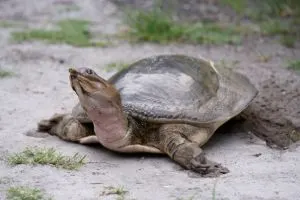
- Experience Level: Intermediate to Expert
- Family: Trionychidae
- Scientific Name: Apalone mutica
- Adult Size: 4 ½ to 7 inches for males, 6 ½ to 14 inches for females
- Lifespan: 25 years and over
- Average Price Range: Between $40 and $60
- Where to Buy: theturtlesource.com
- Recommended Books: Softshell Turtle Owners Guide by Ben Team
The Smooth Softshell turtle favors large rivers with sandy bottoms. In recent years, the number of this species has decreased due to water pollution and channelization.
These turtles have a smooth and flat carapace and a long, tubular snout. Males are smaller than females. They also differ in color. The carapace’s color is brown or grayish with dark blotches, while females have a tan or brown carapace.
Experienced turtle lovers would recognize the Smooth Softshell turtle, even though many people confuse it with the Spiny Softshell turtle.
The Smooth Softshell turtle’s diet consists of crayfish, snails, insects, worms, fish, clams, amphibians, and plants. They can catch their prey both in water and on land.
Conclusion
Many of the turtle species that live in West Virginia are aquatic turtles. Some, however, prefer living in marshy areas, while others prefer to bask on rocks.
Not all turtle species native to West Virginia are omnivorous. The Eastern River cooter is one example of being a herbivore, feeding on various aquatic plants.
The nesting season of the turtles begins in spring and lasts for a couple of months. The clutch size depends on the female turtle the most.
Depending on the experience level, you can determine whether the specific turtle type is ideal for you to keep as a pet. Some species demand particular conditions, while others can adjust to new environments.
Other nearby states
